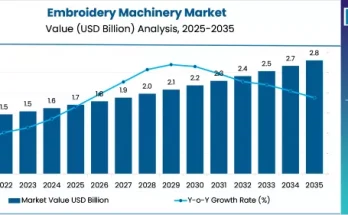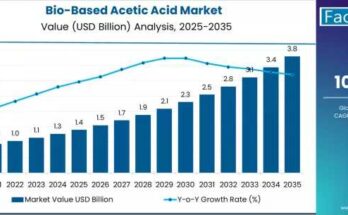The global acetone derivatives market is projected to grow significantly over the coming decade, expanding from US$ 11.2 billion in 2022 to US$ 19.9 billion by 2032, exhibiting a compound annual growth rate (CAGR) of 5.8%. This growth is driven by sustained demand across paint & coatings, renewable energy, mining, and specialty chemical sectors.
Robust Growth Backed by Coatings & Solvents Demand
Acetone derivatives serve as key solvents and intermediates for many chemical formulations. Solvents account for over 50% of global demand and remain a critical growth engine. Derivatives such as methyl isobutyl ketone (MIBK) and isophorone are widely used in high-performance paints and coatings due to their strong solvency, low volatility, and ability to reduce viscosity. These properties make them ideal for high-solid, durable coatings in automotive and industrial paints, where performance and environmental standards are steadily rising.
Urbanization globally has increased demand for decorative and protective coatings, amplifying the need for solvent-grade acetone derivatives. The automotive industry, including both combustion and electric vehicles, adds further demand through lightweight, high-durability coatings that protect against UV, corrosion, and wear.
Renewable Energy Applications Open New Growth Avenues
Beyond traditional uses, acetone derivatives are increasingly applied in renewable energy sectors. Certain derivatives act as chemical intermediates in polycarbonate and epoxy resins, essential for wind turbine blades and other clean-energy components. As investments in wind and solar power continue to surge, these applications are expected to significantly contribute to market growth.
Additionally, methyl methacrylate (MMA) is being adopted as a glass substitute in solar panels. Its shatter-resistant and lightweight properties make it ideal for solar modules, enabling energy-efficient and durable construction.
Mining Sector Gains Traction via MIBC
The mining industry is another growing application area. Methyl isobutyl carbinol (MIBC), derived from MIBK, is widely used as a frother in mineral flotation, aiding selective separation of valuable minerals from slurry. Global demand for technology-critical minerals is rising, creating a fast-growing niche for acetone derivative suppliers.
Regional Trends: East Asia & North America Lead
Regionally, East Asia accounts for roughly 31.7% of global demand, with China as the growth engine, fueled by its booming coatings industry, expanding infrastructure, and strong chemical manufacturing base. China’s acetone derivative demand is projected to grow at 6.2% CAGR through 2032.
In North America, the U.S. dominates the regional market, representing about 87% of regional consumption. Growth is primarily fueled by the cosmetics and personal care industries, as increasing disposable incomes and consumer demand for premium products drive usage of acetone derivatives in haircare and skincare formulations. The U.S. market is forecast to grow at ~5.1% CAGR through 2032.
Product Segmentation & Industrial Drivers
The acetone derivatives market includes key product types:
-
Bisphenol-A (BPA)
-
Diacetone Alcohol (DAA)
-
Methyl Methacrylate (MMA)
-
Isophorone
-
MIBK
MIBK and Bisphenol-A variants are expected to see consistent growth due to use in coatings, resins, and plastics. Chemical-grade derivatives dominate, but food- and pharma-grade segments are also rising with increasing regulatory and purity requirements.
End-use industries include:
-
Paints & Coatings (~33% share)
-
Cosmetics & Personal Care
-
Pharmaceuticals
-
Adhesives
-
Specialty Chemicals
These segments are driving the majority of growth globally.
Competitive Landscape & Innovation
Major players include Kumho P&B Chemical, Mitsubishi Chemical, Celanese, INEOS Phenol, LG Chem, Covestro, Lotte Chemical, SABIC, Sasol, Arkema, Mitsui Chemicals, Solvay, Altivia, LyondellBasell, Braskem, and Shell. Companies are investing in capacity expansion, R&D, and sustainable process innovation, focusing on advanced production technologies, renewable-based products, and strategic partnerships.
Risks & Challenges
The market faces several challenges:
-
Regulatory Pressure: Environmental regulations are increasing compliance costs.
-
Sustainability Threats: Bio-based chemicals and greener alternatives may reduce demand for traditional acetone derivatives.
-
Feedstock Constraints: Consistent raw material supply remains critical.
-
Capital Intensity: High-capex requirements limit entry for smaller players.
Browse Full Report : https://www.factmr.com/report/1439/acetone-derivatives-market
Strategic Implications & Outlook
-
Manufacturers: Invest in R&D, expand capacity, adopt greener technologies.
-
End-users: Leverage acetone derivatives for durability, performance, and compliance.
-
Investors: Consider companies with strong innovation pipelines and expansion plans.
-
Policymakers: Incentivize low-carbon production and circular supply chains to accelerate adoption.
By 2032, the global acetone derivatives market is projected to reach US$ 19.9 billion, nearly doubling in size. Growth will be driven by paints & coatings, renewable energy applications, and mining, supported by cosmetics, pharmaceuticals, and specialty chemicals. Companies aligning with innovation, sustainability, and high-growth sectors are poised to benefit the most.



